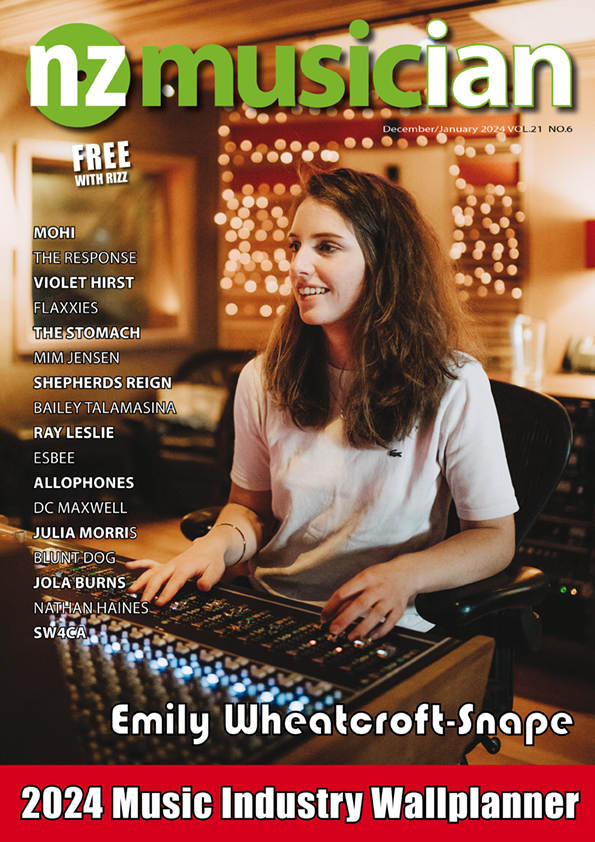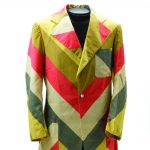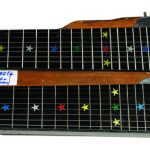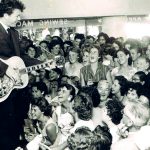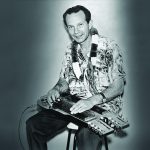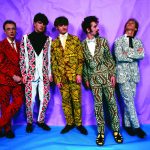Volume: NZ Music On Show At Auckland Museum
Volume: NZ Music On Show At Auckland Museum
It’s early October when we talk and Mark Roach really can’t wait for the next three weeks to pass and Auckland Museum’s new exhibition, Volume : Making Music In Aotearoa to open. It’s three years since “a lightbulb moment” led him down the path of envisaging an actual, tangible hall of fame for NZ music.
The October 28 launch of Volume, a seven month-long special exhibition at Auckland Museum will bring his subsequent journey to a completion. While it won’t exactly be the embodiment of the NZ Music Hall of Fame that Mark first started contemplating, it will in all manner of ways be a much bigger and better exhibition of popular NZ music and the musicians who have made it, well, popular.
Occupying 900sq m of exhibition space at the southern entrance of the Auckland Museum, Volume will take visitors on a journey through the highs (and inevitably some lows) of NZ music since the late 1950s.
The exhibition timeline starts at 1957 – when rock’n’roll got its official start here, with the release of seminal tracks including Pie Cart Rock and Roll, Lawdy Miss Clawdy and Rock Around The Clock. By the time Volume winds up in NZ Music Month next year it will neatly be 60 years since those artists like Johnny Cooper and Johnny Devlin first made teenage hearts swoon and parental ears burn. Pretty much anyone with a pulse (and any NZ history) should, it seems, expect to have memories rekindled in that way that only music does.
The Volume exhibition is organised by decades, each with its own area and interactive experience. There’s a 1970s pub stage with real instruments visitors can play. A record store straight out of the ’80s, complete with vinyl bins to flick through. A DJ – VJ experience covers off the ’90s dance music explosion while the ’00s area includes a mocked up recording studio where complete novices can try their hand at mixing a song.
Anyone who can recall the ’60s will almost certainly love that decade’s recreation of the C’Mon television studio, complete with colourful go go dancers and monochrome TV screens.
Clearly Volume: Making Music in Aotearoa is a far cry from a simple shrine to the 20 acts/individuals who have been inducted into the NZ Music Hall of Fame since its inception in 2007, though each will have their place in the exhibition. Like any great producer, Auckland Museum’s staff have taken the basic acoustic song idea that Mark Roach first submitted and multi-tracked the heck out of it, creating the exhibition equivalent of a wall of sound.
Apparently it’s not uncommon that people approach museums with their wacky specialist exhibit ideas, but it is unusual for those suggestions to be progressed. In contacting Auckland Museum back in 2014 Mark had the distinct advantage of talking as a senior staffer of our music industry’s leading body, Recorded Music NZ. He has the title ‘Special Projects / NZ Music Hall of Fame’ on his business card.
Recorded Music NZ is the organisation that (among other related activities) collects and disseminates music public performance royalties, provides us all with the weekly Top 40 charts and stages the annual NZ Music Awards. The vagueness of his job title probably stems, Mark laughs, from the wide array of roles he undertakes – making a more specific descriptor too unwieldly.
“I do a multitude of different roles that aren’t easily described and often get roped into projects because I have a useful skill set. Broadly I guess it’s a marketing role for Recorded Music NZ.
“Obviously an aspect of the organisation’s role is to advocate and promote the NZ music industry, and the ways that we do that include the charts, the music awards and the Hall of Fame. I became involved in that partly because of my longevity in the industry, as well as the design skills I have.”
Two acts get inducted into the NZ Music Hall of Fame each year, one at APRA’s Silver Scroll Awards ceremony and another at November’s NZ Music Awards. The genesis of that awkward scenario lies in both organisations separately thinking about doing something hall-of-fame-ish around the same period. Rather than compete, RIANZ (as it was then) and APRA agreed to combine their plans. The easiest accommodation was for each to do an induction at their annual ceremonies, with both constituting entry into the NZ Music Hall of Fame.
That was about as far as their early agreement extended however and the whole thing desperately lacked cohesion, with differing branding, mixed messages and general industry and public confusion. There was, of course, no evidence of an actual hall – after six years not even a website.
Mark recalls talking about it with his then boss Chris Caddick in 2014 and asking what this metaphorical hall of fame might look like.
“That was a lightbulb moment, when I thought we should have somewhere that we can celebrate our inductees. That started me on the path towards this project.”
The combined NZ Music Hall of Fame relationships were formalised with the establishment a trust, and regular strategy meetings led to the development of an online ‘virtual’ hall early last year.
Mark describes that as the first stage, with the long term goal being to have a permanent place to celebrate NZ music. Off his own bat he started researching music museums around the world. He cites the British Music Experience that he visited in London. It collapsed after a few years but is due to re-open in Liverpool following a tendering process. In a similar vein he mentions a rugby hall of fame optimistically set up in Auckland CBD’s Chase Plaza back in the early 1990s that also spectacularly failed.
“Overwhelming evidence was that, unless you can road test these things and get a feel for what the public actually want, there’s no point in building a museum. So the best idea is to build a small scale version, gauge reactions, get lots of feedback – and that’s really what this exhibition is, kind of a stage two.”
It was just two years ago, September 2014, when he first contacted the museum on behalf of Recorded Music NZ.
“As I was writing the pitch [for Auckland Museum] I realised that it would be too prescriptive to keep the exhibition to Hall of Fame inductees – why don’t we make it about the whole of NZ music and have a Hall of Fame section in it?
“I realised this wasn’t just about the Hall of Fame or about inductees, it was about celebrating all of NZ music. And in a way that’s what the NZ Music Hall of Fame is trying to do as well. We only induct two artists a year because it’s a rarified atmosphere, the highest peer accolade in our industry, and the concept has never been to induct too many because that would distill the honour.”
He describes Volume as touting the history of NZ’s ‘popular’ music.
“It’s not going right back to the 1940s and the likes of Blue Smoke – more the history of Kiwi rock’n’roll I guess – but we can’t say that as there are so many other genres included.”
Auckland Museum describes Volume as a landmark exhibition that ‘brings the music of our nation to life through hundreds of songs, stories, costumes, instruments, handwritten lyrics and images generously loaned by some of our best loved musicians’. Exhibition organisers engaged veteran music writer Graham Reid as content advisor, researching and detailing the key players, movers, shakers and events over seven decades of NZ music. Quite some task.
- Alastair Riddell’s (Space Waltz) suit from 1974
- Bill Sevesi and his lap steel guitar.
- Johnny Devlin making a record store appearance, 1958/59.
- Bill Sevesi and his lap steel guitar.
- Split Enz circa 1978, photographer Bonnie Schiffman
The visitor experience will start with the present NZ music scene, progressing back in time through the ’00s, ’90s, ’80s, ’70s and 1960s/’50s. Each decade has its own interactive aspect – an opportunity to get hands-on, or rather ‘ears-on’. For the ’00s it’s a recording studio where you can try your hand at mixing a song.
“It’s rudimentary, five or six instrument tracks, but enough to give people a taste.”
The ’90s interactive is a DJ and VJ experience while the ’80s is, rather oddly it seems considering they actually do still exist, a record store.
“Initially I thought that would be a bit flat as an interactive experience but the museum has a youth advisory group. They tested it out on them and it rated through the roof! For a generation now it’s an alien experience, and they thought that sifting through record bins was really cool,” he laughs.
Mark was himself largely responsible for producing the ‘vinyl’ – actually just replica album outer sleeves with the original covers on the front. For the flipside music journalist Russell Baillie was contracted to write bullet-point bios, with band information and related insights.
“The initial concept was to flood it with second hand records, from various record stores, but as we progressed that idea a number of issues became apparent. We couldn’t get some of the key records we wanted, and some we could were horrendously expensive, and over time you have to think about stock damage and even breakage – over seven months a lot of hands will be touching those records.”
Between the museum team, Mark, Russell Baillie and Volume content specialist Graham Reid 185 Kiwi albums were identified as being important enough to warrant inclusion.
He notes that it’s a good way to get more artists into the exhibition, but, as with all aspects, they had to draw a line at some point. It is literally an ’80s record store so the ‘vinyl’ included only goes up to 31st December 1989, anything released after that doesn’t feature.
The 1970s interactive feature is a pub stage – which Mark reckons will be the most fun interactive part of the exhibition.
“It’s sort of every pub, so it could be the Windsor Castle, or it could be The Gluepot sort of thing… People can pick up instruments and play along with a song. There’s a guitar, a bass, drum kit and keyboards. They are all proper instruments that have been retro-fitted with LED lights that guide you what to play – and there’s a huge projection in front showing a crowd going nuts and dancing along (in time) to the music you’re playing!”
He giggles with glee and apparent disbelief – admitting he hadn’t realised the exhibition staff were kitting out actual instruments. The crowd footage was recently recreated and he recommends keeping a close eye out for familiar faces.
Celebrating the 1960s is a recreation of the C’Mon television studio – the spirit of Pete Sinclair is strong with that one.
“The cool thing about that is that you get to see the C’Mon studio in its full technicolour glory – I’d never seen it in colour! I’d only seen the black and white TV footage. They’ve researched and figured out what all the colours were. The go go dancers projected onto the screen are wearing vivid yellow dresses with red swirls.
“There’s a black and white TV screen in there too, so you will be able to see how this amazingly vibrant era of music and fashion was stripped to monochrome in those early days of television technology.
“Again, it’s nice to show pretty much anyone who wasn’t a teenager in the ’60s just how colourful and amazing that era was. There are all sorts of layers that I think visitors will take away.”
Indeed, all sorts of mental, historical and even emotional layers, as well, of course, as all manner of merchandise to purchase from the Volume pop up shop. Along with the usual merch like t-towels, T-shirts, cushions, coasters, picks, pens – and record players – a nine-disc /180-track CD collection has been prepared for release which will be available for sale within the exhibition. Essentially a double disc set for each decade covered, the music will be available separately and digitally as well.
About a quarter of a million visitors are expected to attend the Volume exhibition between the end of October and May 22 next year.
“I think it‘s quite an honour to be presented like this,” Mark finishes, noting that the longest Auckland Museum exhibition prior to this was six months. “Having the museum commit seven months to this exhibition is massive, and all the costs are being borne by the museum.
“In context there are nearly 200 objects and 500 images. Both those figures are probably double what you would expect to find in a normal exhibition at this museum.
“There is a huge number of staff here who have been working on it, I keep meeting more people! It’s a massive commitment and ultimately I think it points to how much people like NZ music, and how much they want to celebrate it.
